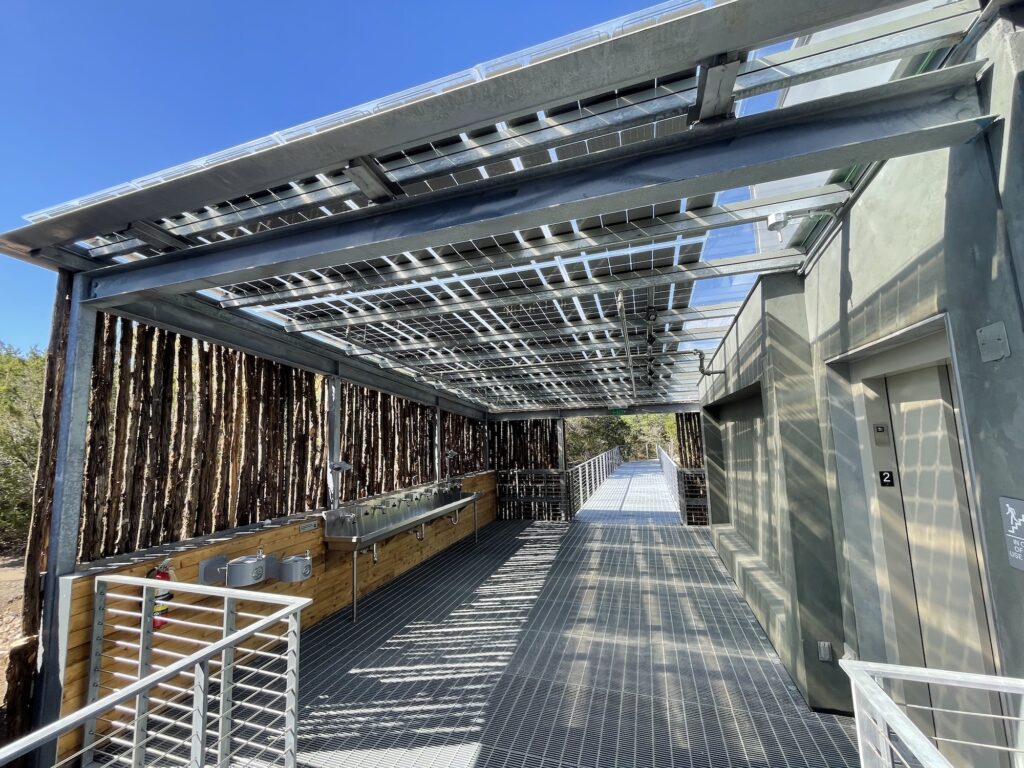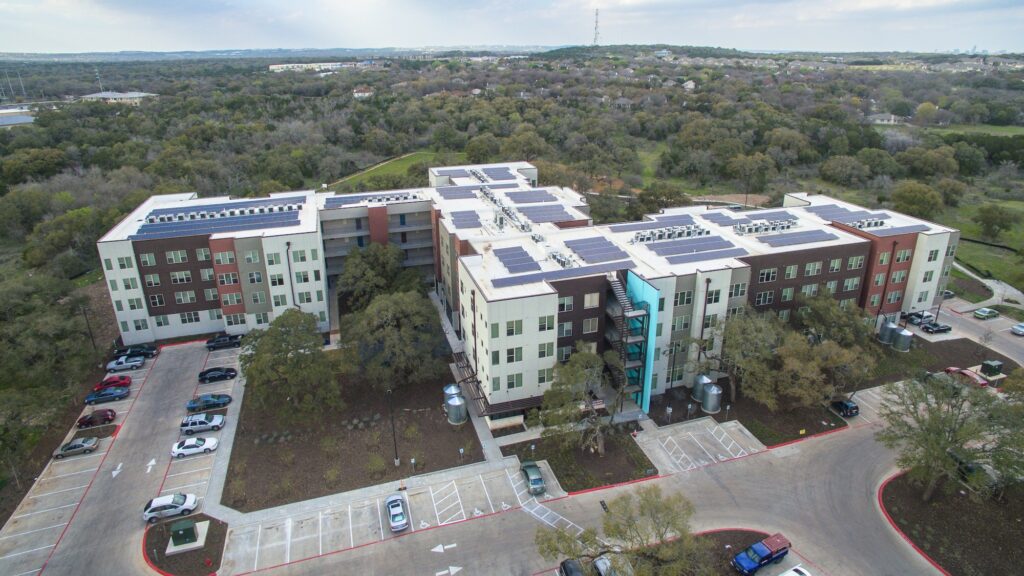Starting with two employees in 2007, TXSES Platinum business member, Lighthouse Solar, now has 40 employees. Stan has been a key player in shaping local and state policies to nurture more favorable conditions for solar’s growth in Texas. Trained as an architect, Stan’s architectural design practice, Pipkinc, focuses on integrated solar design and holistic architectural design services. We caught up with Stan despite his insanely busy schedule. Here’s our conversation.
TXSES: Who or what inspired you to get into the solar industry?
SP: An unlikely place: a dive bar in Houston, where I heard a couple of young energy traders talking enthusiastically about energy. At the time (2007), I was practicing architecture in Houston, frustrated with the lack of attention our industry was giving to energy. I was curious about the relationship between energy and buildings, wondering why the architecture and engineering disciplines weren’t more aligned with more creative and exploratory solutions.
TXSES: Back then, it really wasn’t the practice for those disciplines to interact. I remember those days.
SP: Back in the day, we were very siloed. We seldom asked ‘is this the right problem to solve?’ I was looking at this from a sustainability perspective; that’s how I’m hardwired. Around 2006-2007, I was invited to start a solar company in Austin, an expansion of a Boulder-based firm. Solar was new to me but with my inherent sustainability bent, I realized the overlap of solar and architecture made so much sense.
TXSES: What happened next?
SP: I left Houston, moved back to Austin and helped launch Lighthouse Solar with a new problem to consider: Can solar drive innovation in the building community? My architectural foray into emerging tech and market development revealed an entirely new set of problems to solve.
TXSES: It must give you a great deal of comfort and satisfaction to see the change and know you’ve played an important part in the change.
SP: This thread is still central to my work in architecture and solar; it’s kept me humble for a long time. It’s also satisfying to see consumer demand for more energy-efficient buildings and solar. LEED (Leadership in Energy and Environmental Design) has helped pull our industry forward, as have utilities like Austin’s Green Building Program. People are now interested in a higher level of envelope performance and integrated design.
TXSES: Talk about the state of the solar workforce and how it’s impacting your work. We hear from our installer business members that they’re desperate for more trained solar installers. What schooling and training are necessary to build a strong solar workforce?
SP: Here in Austin, where we’ve got a strong economy and an even stronger tech-focused workforce, the trades are getting short shrift. The solar workforce, which is still evolving, requires a combination of skills, some of which are customer-facing. A career in distributed solar is a new form of worker that includes altruistic ambitions, knowledge and technical skills, combined with sophisticated soft skills like problem-solving, communication and other cognitive capabilities. Most trades don’t focus on those areas.
Our approach at Lighthouse Solar, whether it’s sales or project management, is to look for people who have had a full professional life somewhere else. We’ve had teachers, folks who have run small businesses; they’re mature and take responsibility for their work. Then they learn about solar. As much as we’d like things to be strictly process-driven, it’s not been our model. It’s been really challenging through the pandemic and even now. Like other installers, our greatest need is on the installation side. We’re lucky that we’ve had some installers who have been with us for 10 years. Folks are very ambitious. We’ve had five businesses incubate out of Lighthouse Solar, some of whom are competitors now.
TXSES: Guess you trained them well. Would you say it’s important for industry to partner with educators to develop the right skills and turn that into curriculum?
SP: Definitely. We’ve been partnering with some high schools to help students understand that solar isn’t just a set of widgets on top of a roof. It’s an integrated approach to total customer experience with evolving technologies. Those facets are out of step with most American trades.
TXSES: What’s Lighthouse’s breakdown of installed systems; residential v. commercial. What about storage?
SP: By volume and revenue, it’s mostly residential. For commercial, we do a lot of new construction so it’s easy to integrate solar into the planning process. Today, the average residential system size is about 12kW. And yes, nearly every conversation we have with customers today does include storage. We recently commissioned a large residential system in Austin and even though it’s grid-connected, it can run off-grid as its own microgrid which is pretty unusual. We also completed an outdoor science camp at Shield Ranch that’s totally off the grid.

Shield Ranch: Immersive environmental science camp completely off-grid with a solar, storage and generator microgrid. 67 kW solar array and a 200 kWh lithium battery bank designed to power the complex of buildings, including a kitchen, dining room, offices, classrooms and cabins on the banks of Barton Creek near Dripping Springs. Credit: Lighthouse Solar
TXSES: I know it’s hard to pick a favorite project but tell us about a memorable one.
SP: The Homestead Oaks project in Austin was a really interesting one. A multi-family project of Foundation Communities, the idea was to go solar for all 140 units, which meant 140 separate systems, and with interconnection rules, that meant 140 applications! It was crazy, but the effort to avoid that brain damage in the future helped spur the genesis of Austin Energy’s shared solar program. It ultimately worked out to make solar affordable for low-income housing but it was a huge challenge to pull it off.
TXSES: Let’s switch gears and talk about your work with the Architectural Solar Association.
SP: We’re pretty excited about this project. I’m a co-founder of this Boulder-based organization, the mission of which is to remedy exactly what we’ve been talking about: the disconnect between solar and buildings. In fact, we just were awarded a three-year U.S. Department of Energy grant. Working with NREL (National Renewable Energy Laboratory), we’ll develop educational content, disseminate it to the architectural, engineering, contracting communities and develop practices that would encourage more integrated approaches to solar.
TXSES: You mean like BIPV?
SP: This isn’t BIPV (building integrated PV). It’s architectural solar. It’s friendlier, speaks to a broader set of applications and addresses the question, ‘what is your building doing about energy?’ We’ve just kicked off this three-year initiative targeted for professionals that will include tools, design concepts and best practices to get to zero-energy buildings. The basis of the curriculum will show professionals how to think about active solar energy systems in the building envelope and constituent parts.
TXSES: How will you disseminate the curriculum?
SP: We’ll make it available through HeatSpring (online portal with courses for professionals in solar PV, design, installation, NABCEP (North American Board of Certified Energy Practitioners) certification and other solar and green building topics). AIA continuing education credits will be available. Folks can learn more about our work at https://www.archsolar.org
TXSES: One last question: where do you see Lighthouse Solar in five years?
SP: We’re at an inflection point. There’s been a change of ownership; we’ve gone through some restructuring and now we’re growing our internal teams. Although Austin is our base, we’re looking to expand in Texas. Our goal for Lighthouse: we’re a business that honors our current customers with ideas that were rooted in this community. One key thing of my interest and our business model: you have to be of the community in which you practice. This isn’t a get-rich-quick scheme. Things don’t get better the more remote you are from the source. You must be part of the community to produce value for that community.
TXSES: We’re so appreciative of your trailblazing work, Stan. Many thanks for all you do.
To learn more about Lighthouse Solar, visit https://lighthousesolartx.com

